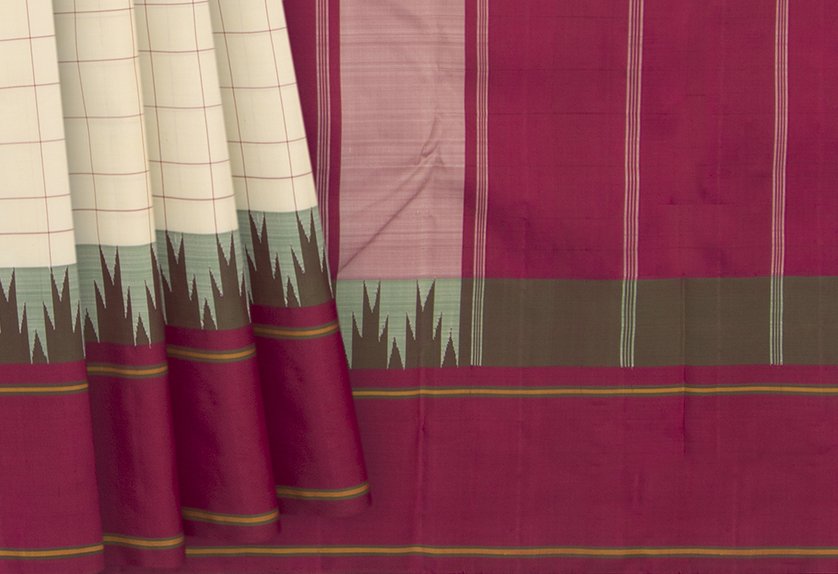Like the structure that inspires it, the temple motif is subtle and yet rich with meaning.
Could the temple pattern be the most iconic of Kanchipuram’s motifs? Kanchipuram is, after all, a renowned center of pilgrimage. It is the most quintessential of southern Indian temple towns, and countless gopurams (temple gateways) soar above its quaint neighborhoods, beckoning people to prayer.

In India, craft reflects culture. Many of India’s craft traditions are hundreds of years old, originating in eras when one’s mental map stretched only as far as adjacent villages and small towns.
Weavers and artists drew on local, everyday experiences for inspiration. In Kanchipuram, temples are the centers of community life and define the ethos of its craftspeople.
In that sense, the temple pattern is the leitmotif of life in Kanchipuram.
The many avatars of the temple border :
A temple border is easily spotted; its recurring motifs are triangular and often layered, resembling the gopuram’s brilliantly-nuanced design as it arches skyward. Yet, the temple motif is so widely used that its subtle differences and versatility are often unnoticed.
Did you know, for instance, that there are several types of temple patterns?
Thazampoo reku is named after the sacred flower of the screw pine, for it too is wide and sharp-edged.

In contrast, the pillayar moggu is dainty with smooth contours, resembling a bud on the verge of blossoming. Hence the name ‘moggu’, which means ‘bud’ in Tamil.

The striped seepu reku often occurs on pallus, yet its tapering pattern distinguishes it as a variation of the temple motif. Its evenly-spaced, slender lines resemble a comb or ‘seepu’ in Tamil.

Temple borders and the art of korvai :
The most distinctive handwoven Kanchipuram silk sarees are those with the korvai border. The word ‘korvai’ instantly calls to mind a colorful Kanchipuram weave with a high degree of contrast between the body on the one hand, and the border and pallu on the other.
‘Korvai’ means ‘harmony’, and the word is applied across music, dance, and weaving. In the case of handwoven Kanchipuram silk sarees, it alludes to the interlocking of the body with the border and pallu, which are woven separately. A korvai saree gives weavers the freedom to experiment; often, you’ll find that the colours and patterns of the body are in stark contrast with those of the border and pallu. These separate parts are brought together in one seamless design by two weavers working side by side at the loom.

Their favorite method of interlocking the body with the border and pallu is the temple pattern. And that’s why you’ll most often find the temple motif at the point where the body and border meet; it forms the bridge, the bringer of harmony between two disparate elements. Ponder on this a while, and one realizes that perhaps there’s no motif better suited to the job. After all, isn’t the structure that it’s named after, the gopuram, itself a bridge between heaven and earth, a gateway to the realm of the gods?
[Browse our selection of handwoven sarees featuring the temple motif here.]

